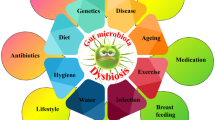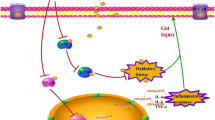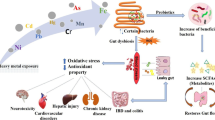Abstract
Probiotics alleviate the toxicity of environmental pollutants by regulating the composition and function of gut microbiota, which are termed as “gut remediation.” Compared to current remediation technology, gut remediation appears to be a novel remediation approach to repair tissue damage caused by various pollutants. Recently, gut remediation has been used for in vivo remediation of pollution. This chapter mainly reviews how to reduce heavy metals and organic contaminants in the gut. Some successful research cases are listed. Additionally, an essential consideration for probiotics is how to successfully introduce a/some strain(s) with desired function as well as robust colonization into recipient communities, which merit formulating probiotics regimen design based on the consumer in differing clinical contexts.
Access this chapter
Tax calculation will be finalised at checkout
Purchases are for personal use only
Similar content being viewed by others
References
Chen HM et al (2000) Chemical methods and phytoremediation of soil contaminated with heavy metals. Chemosphere 41(1-2):229–234
Antoci A, Galeotti M, Sordi S (2018) Environmental pollution as engine of industrialization. Communications in Nonlinear Science and Numerical Simulation 58:262–273
Wang QYD, Cui Y, Liu X (2001) Instances of soil and crop heavy metal contamination in China. Soil Sediment Contam 10(5):497–510
Aoshima K (2012) [Itai-itai disease: cadmium-induced renal tubular osteomalacia]. Nihon Eiseigaku Zasshi 67(4):455463.
Collen A, Smith JJB (2015) 10% Human: How Your body’s Microbes Hold the Key to Health and Happiness. 9(780316):380102
Cani PD, Delzenne NM (2011) The gut microbiome as therapeutic target. Pharmacology & Therapeutics 130(2):202–212
Woodhouse CA et al (2018) Review article: the gut microbiome as a therapeutic target in the pathogenesis and treatment of chronic liver disease. Alimentary Pharmacology & Therapeutics 47(2):192–202
Knight DJW, Girling KJ (2003) Gut flora in health and disease. Lancet 361(9371):1831–1831
Guarner F, Malagelada JR (2003) Gut flora in health and disease. Lancet 361(9356):512–519
Gordon JI (2012) Honor thy gut symbionts redux. Science 336(6086):1251–1253
Frank DN et al (2007) Molecular-phylogenetic characterization of microbial community imbalances in human inflammatory bowel diseases. Proc Natl Acad Sci U S A 104(34):13780–13785
Schloss PD, Handelsman J (2004) Status of the microbial census. Microbiol Mol Biol Rev 68(4):686–691
Gough E, Shaikh H, Manges AR (2011) Systematic review of intestinal microbiota transplantation (fecal bacteriotherapy) for recurrent Clostridium difficile infection. Clin Infect Dis 53(10):994–1002
Hartmann P, Chen WC, Schnabl B (2012) The intestinal microbiome and the leaky gut as therapeutic targets in alcoholic liver disease. Frontiers in Physiology 3:402
Nishida AH, Ochman H (2018) Rates of gut microbiome divergence in mammals. Molecular Ecology 27(8):1884–1897
Winek K, Dirnagl U, Meisel A (2016) The Gut Microbiome as Therapeutic Target in Central Nervous System Diseases: Implications for Stroke. Neurotherapeutics 13(4):762–774
O’Hara AM, Shanahan F (2006) The gut flora as a forgotten organ. Embo Reports 7(7):688–693
Pei Y et al (2018) Microbial community structure and function indicate the severity of chromium contamination of the Yellow River. 9:38
Yu Z et al (2014) A mer operon confers mercury reduction in a Staphylococcus epidermidis strain isolated from Lanzhou reach of the Yellow River. 90:57–63
Zheng Z et al (2015) A Bacillus subtilis strain can reduce hexavalent chromium to trivalent and an nfrA gene is involved. 97:90–96
Chen Y et al (2018) Long-term and high-concentration heavy-metal contamination strongly influences the microbiome and functional genes in Yellow River sediments. 637:1400–1412
Jiang Y et al (2015) Pseudomonas sp. LZ-Q continuously degrades phenanthrene under hypersaline and hyperalkaline condition in a membrane bioreactor system. 1(3):156–167
Huang H et al (2017) The naphthalene catabolic protein NahG plays a key role in hexavalent chromium reduction in Pseudomonas brassicacearum LZ-4. 7(1):1–11
Wu W et al (2016) Genome sequencing reveals mechanisms for heavy metal resistance and polycyclic aromatic hydrocarbon degradation in Delftia lacustris strain LZ-C. 25(1):234–247
Yu X et al (2016) Simultaneous aerobic denitrification and Cr (VI) reduction by Pseudomonas brassicacearum LZ-4 in wastewater. 221:121–129
Huang H et al (2016) A novel Pseudomonas gessardii strain LZ-E simultaneously degrades naphthalene and reduces hexavalent chromium. 207:370–378
Xu R et al (2018) Co-expression of YieF and PhoN in Deinococcus radiodurans R1 improves uranium bioprecipitation by reducing chromium interference. 211:1156–1165
Boopathy R (2000) Factors limiting bioremediation technologies. Bioresource Technology 74(1):63–67
Souiri M et al (2009) Escherichia coli-functionalized magnetic nanobeads as an ultrasensitive biosensor for heavy metals. Procedia Chem 1(1):1027–1030
Biswas JK et al (2018) Exploring potential applications of a novel extracellular polymeric substance synthesizing bacterium (Bacillus licheniformis) isolated from gut contents of earthworm (Metaphire posthuma) in environmental remediation. Biodegradation 29(4):323–337
Cai M et al (2018) Systematic characterization and proposed pathway of tetracycline degradation in solid waste treatment by Hermetia illucens with intestinal microbiota. Environ Pollut 242(Pt A):634–642
Halttunen T et al (2008) Combining strains of lactic acid bacteria may reduce their toxin and heavy metal removal efficiency from aqueous solution. Lett Appl Microbiol 46(2):160–165
Feng PY et al (2019) A Review on Gut Remediation of Selected Environmental Contaminants: Possible Roles of Probiotics and Gut Microbiota. Nutrients 11(1)
Carter LJ et al (2014) Fate and uptake of pharmaceuticals in soil-earthworm systems. Environ Sci Technol 48(10):5955–5963
Sinha RK, Bharambe G, Ryan D (2008) Converting wasteland into wonderland by earthworms—a low-cost nature’s technology for soil remediation: a case study of vermiremediation of PAHs contaminated soil. The Environmentalist 28(4):466–475
Nagaoka M et al (1995) Structural studies on a cell wall polysaccharide from Bifidobacterium longum YIT4028. Carbohydr Res 274:245–249
Landersjo C et al (2002) Structural studies of the exopolysaccharide produced by Lactobacillus rhamnosus strain GG (ATCC 53103). Biomacromolecules 3(4):880–884
Frece J et al (2005) In vivo Testing of Functional Properties of Three Selected Probiotic Strains. World Journal of Microbiology and Biotechnology 21(8):1401
Avall-Jaaskelainen S, Lindholm A, Palva A (2003) Surface display of the receptor-binding region of the Lactobacillus brevis S-layer protein in Lactococcus lactis provides nonadhesive lactococci with the ability to adhere to intestinal epithelial cells. Appl Environ Microbiol 69(4):2230–2236
Jadán-Piedra C et al (2017) The use of lactic acid bacteria to reduce mercury bioaccessibility. Food Chemistry 228:158–166
Kelleher SL et al (2002) Supplementation of infant formula with the probiotic lactobacillus reuteri and zinc: impact on enteric infection and nutrition in infant rhesus monkeys. J Pediatr Gastroenterol Nutr 35(2):162–168
Scholz-Ahrens KE et al (2007) Prebiotics, probiotics, and synbiotics affect mineral absorption, bone mineral content, and bone structure. J Nutr 137(3 Suppl 2):838S–846S
Zhai Q et al (2016) Oral administration of probiotics inhibits absorption of the Heavy Metal Cadmium by Protecting the Intestinal Barrier. Appl Environ Microbiol 82(14):4429–4440
Yu L et al (2016) Potential of Lactobacillus plantarum CCFM639 in Protecting against Aluminum Toxicity Mediated by Intestinal Barrier Function and Oxidative Stress. Nutrients 8(12):783
Wu G et al (2017) Gut remediation: a potential approach to reducing chromium accumulation using Lactobacillus plantarum TW1-1. Sci Rep 7(1):15000
Zmora N et al (2018) Personalized Gut Mucosal Colonization Resistance to Empiric Probiotics Is Associated with Unique Host and Microbiome Features. Cell 174(6):1388–1405. e21
Bisanz JE et al (2014) Randomized open-label pilot study of the influence of probiotics and the gut microbiome on toxic metal levels in Tanzanian pregnant women and school children. MBio 5(5):e01580-14
Zhai Q et al (2014) Protective effects of Lactobacillus plantarum CCFM8610 against chronic cadmium toxicity in mice indicate routes of protection besides intestinal sequestration. Appl. Environ. Microbiol. 80(13):4063–4071
Li B et al (2014) Mercury nano-trap for effective and efficient removal of mercury (II) from aqueous solution. Nature communications 5:5537
Liu YR et al (2016) Effects of cellular Sorption on mercury bioavailability and methylmercury production by Desulfovibrio desulfuricans ND132. Environmental Science & Technology 50(24):13335–13341
Chang D-E et al (2004) Carbon nutrition of Escherichia coli in the mouse intestine. Proceedings of the National Academy of Sciences of the United States of America 101(19):7427–7432
Liu M et al (2019) Hg2+-binding peptide decreases mercury ion accumulation in fish through a cell surface display system. Science of The Total Environment 659:540–547
Cabral L et al (2016) Methylmercury degradation by Pseudomonas putida V1. Ecotoxicology and environmental safety 130:37–42
Zhang W et al (2018) Risk assessment of total mercury and methylmercury in aquatic products from offshore farms in China. Journal of Hazardous Materials 354:198–205
Cerveny D et al (2016) Young-of-the-year fish as a prospective bioindicator for aquatic environmental contamination monitoring. Water research 103:334–342
Hsu-Kim H et al (2013) Mechanisms regulating mercury bioavailability for methylating microorganisms in the aquatic environment: a critical review. Environmental science & technology 47(6):2441–2456
Zhou HY, Wong MH (2000) Mercury accumulation in freshwater fish with emphasis on the dietary influence. Water Research 34(17):4234–4242
Harada M (1995) Minamata Disease: Methylmercury Poisoning in Japan Caused by Environmental Pollution. Critical Reviews in Toxicology 25(1):24
Tuzen M et al (2009) Mercury (II) and methyl mercury determinations in water and fish samples by using solid phase extraction and cold vapour atomic absorption spectrometry combination. Food and Chemical Toxicology 47(7):1648–1652
Liu M et al (2019) Reducing methylmercury accumulation in fish using Escherichia coli with surface-displayed methylmercury-binding peptides. Journal of Hazardous Materials 367:35–42
Uchikawa T et al (2010) The influence of Parachlorella beyerinckii CK-5 on the absorption and excretion of methylmercury (MeHg) in mice. The Journal of toxicological sciences 35(1):101–105
Nakamori M et al (2016) Oral administration of erythromycin decreases RNA toxicity in myotonic dystrophy. Ann Clin Transl Neurol 3(1):42–54
Zhai Q et al (2020) Oral Supplementation of Lead-Intolerant Intestinal Microbes Protects Against Lead (Pb) Toxicity in Mice. Frontiers in Microbiology 10:3161
Ezzariai A et al (2018) Human and veterinary antibiotics during composting of sludge or manure: Global perspectives on persistence, degradation, and resistance genes. Journal of Hazardous Materials 359:465–481
Liu M et al (2019) Pretreatment of swine manure containing β-lactam antibiotics with whole-cell biocatalyst to improve biogas production. Journal of Cleaner Production 240:118070
Kafaei R et al (2018) Occurrence, distribution, and potential sources of antibiotics pollution in the water-sediment of the northern coastline of the Persian Gulf, Iran. Sci Total Environ 627:703–712
de Cazes M et al (2016) Erythromycin degradation by esterase (EreB) in enzymatic membrane reactors. Biochemical Engineering Journal 114:70–78
Minami T et al (1996) Effects of erythromycin in chronic idiopathic intestinal pseudo-obstruction. Journal of Gastroenterology 31(6):855–859
Kohno Y et al (1989) Comparative pharmacokinetics of clarithromycin (TE-031), a new macrolide antibiotic, and erythromycin in rats. Antimicrobial Agents and Chemotherapy 33(5):751–756
Dubreuil JD (2014) Escherichia coli | Enterotoxigenic E. coli (ETEC). In: Batt CA, Tortorello ML (eds) Encyclopedia of Food Microbiology, 2nd edn. Academic Press, Oxford, pp 728–734
Liu M et al (2020) Reducing residual antibiotic levels in animal feces using intestinal Escherichia coli with surface-displayed erythromycin esterase. Journal of Hazardous Materials 388:122032
Hernández-Castellanos B et al (2013) Removal of benzo (a) pyrene from soil using an endogeic earthworm Pontoscolex corethrurus (). Applied soil ecology 70:62–69
Kersanté A et al (2006) Interactions of earthworms with atrazine-degrading bacteria in an agricultural soil. FEMS microbiology ecology 57(2):192–205
Singleton DR et al (2003) Identification of uncultured bacteria tightly associated with the intestine of the earthworm Lumbricus rubellus (Lumbricidae; Oligochaeta). Soil Biology and Biochemistry 35(12):1547–1555
Weinbreck, F., I. Bodnár, and M.J.I.j.o.f.m. Marco, Can encapsulation lengthen the shelf-life of probiotic bacteria in dry products? 2010. 136(3): p. 364-367.
de Araújo Etchepare M et al (2016) Effect of resistant starch and chitosan on survival of Lactobacillus acidophilus microencapsulated with sodium alginate. 65:511–517
Broeckx G et al (2016) Drying techniques of probiotic bacteria as an important step towards the development of novel pharmabiotics. 505(1-2):303–318
Hotel, A.C.P. aand AA.J.P. Cordoba, Health and nutritional properties of probiotics in food including powder milk with live lactic acid bacteria.. 2001. 5(1): p. 1-10.
Sohail A et al (2011) Survivability of probiotics encapsulated in alginate gel microbeads using a novel impinging aerosols method. 145(1):162–168
Doherty S et al (2011) Development and characterisation of whey protein micro-beads as potential matrices for probiotic protection. 25(6):1604–1617
Doherty S et al (2012) Survival of entrapped Lactobacillus rhamnosus GG in whey protein micro-beads during simulated ex vivo gastro-intestinal transit. 22(1):31–43
Dimitrellou D et al (2016) Survival of spray dried microencapsulated Lactobacillus casei ATCC 393 in simulated gastrointestinal conditions and fermented milk. 71:169–174
Huang S et al (2016) Double use of highly concentrated sweet whey to improve the biomass production and viability of spray-dried probiotic bacteria. 23:453–463
Mortazavian A, Sohrabvandi SJEP, Tehran (2006) Probiotics and food probiotic products; based on dairy probiotic products..
Oliveira AC et al (2007) Stability of microencapsulated B. lactis (BI 01) and L. acidophilus (LAC 4) by complex coacervation followed by spray drying. 24(7):685–693
Jiménez-Pranteda ML et al (2012) Stability of lactobacilli encapsulated in various microbial polymers. 113(2):179–184
Krasaekoopt, W., B. Bhandari, and H.J.I.d.j. Deeth, Evaluation of encapsulation techniques of probiotics for yoghurt. 2003. 13(1): p. 3-13.
Su R et al (2011) Encapsulation of probiotic Bifidobacterium longum BIOMA 5920 with alginate–human-like collagen and evaluation of survival in simulated gastrointestinal conditions. 49(5):979–984
Shaharuddin, S. and I.I.J.C.p. Muhamad, Microencapsulation of alginate-immobilized bagasse with Lactobacillus rhamnosus NRRL 442: Enhancement of survivability and thermotolerance. 2015. 119: p. 173-181.
Sohail A et al (2013) The viability of Lactobacillus rhamnosus GG and Lactobacillus acidophilus NCFM following double encapsulation in alginate and maltodextrin. 6(10):2763–2769
Sousa S et al (2015) Characterization of freezing effect upon stability of, probiotic loaded, calcium-alginate microparticles. 93:90–97
Yeung TW et al (2016) Microencapsulation of probiotics in hydrogel particles: enhancing Lactococcus lactis subsp. cremoris LM0230 viability using calcium alginate beads. 7(4):1797–1804
Yeung TW et al (2016) Microencapsulation in alginate and chitosan microgels to enhance viability of Bifidobacterium longum for oral delivery. 7:494
Lee, K.-Y. and T.-R.J.A.E.M. Heo, Survival of Bifidobacterium longum immobilized in calcium alginate beads in simulated gastric juices and bile salt solution.. 2000. 66(2): p. 869-873.
Adhikari K et al (2000) Viability of Microencapsulated Bifidobacteria in Set Yogurt During Refrigerated Storage1. 83(9):1946–1951
Abbaszadeh S et al (2014) The effect of alginate and chitosan concentrations on some properties of chitosan-coated alginate beads and survivability of encapsulated Lactobacillus rhamnosus in simulated gastrointestinal conditions and during heat processing. 94(11):2210–2216
Mandal S et al (2014) Enhancement of survival of alginate-encapsulated Lactobacillus casei NCDC 298. 94(10):1994–2001
Kim S-J et al (2008) Effect of microencapsulation on viability and other characteristics in Lactobacillus acidophilus ATCC 43121. 41(3):493–500
Sultana K et al (2000) Encapsulation of probiotic bacteria with alginate–starch and evaluation of survival in simulated gastrointestinal conditions and in yoghurt. 62(1-2):47–55
Chávarri M et al (2010) Microencapsulation of a probiotic and prebiotic in alginate-chitosan capsules improves survival in simulated gastro-intestinal conditions. 142(1-2):185–189
Nag, A., K.-S. Han, and H.J.I.D.J. Singh, Microencapsulation of probiotic bacteria using pH-induced gelation of sodium caseinate and gellan gum. 2011. 21(4): p. 247-253.
Homayouni A et al (2008) Effect of microencapsulation and resistant starch on the probiotic survival and sensory properties of synbiotic ice cream. 111(1):50–55
Coghetto CC et al (2016) Electrospraying microencapsulation of Lactobacillus plantarum enhances cell viability under refrigeration storage and simulated gastric and intestinal fluids. 24:316–326
Ghibaudo F et al (2017) Pectin-iron capsules: Novel system to stabilise and deliver lactic acid bacteria. 39:299–305
Takei T et al (2017) Air drying on superamphiphobic surfaces can reduce damage by organic solvents to microbial cells immobilized in synthetic resin capsules. 54:28–32
Hassanzadeh AM et al (2017) Immobilization and microencapsulation of Lactobacillus caseii and Lactobacillus plantarum using zeolite base and evaluating their viability in gastroesophageal-intestine simulated condition.
Alehosseini A et al (2019) Agarose-based freeze-dried capsules prepared by the oil-induced biphasic hydrogel particle formation approach for the protection of sensitive probiotic bacteria. 87:487–496
Author information
Authors and Affiliations
Corresponding author
Editor information
Editors and Affiliations
Rights and permissions
Copyright information
© 2020 Springer Nature Singapore Pte Ltd.
About this chapter
Cite this chapter
Ling, Z., Jiang, Y., Li, X. (2020). Gut Remediation: Back to the Future. In: Li, X., Liu, P. (eds) Gut Remediation of Environmental Pollutants. Springer, Singapore. https://doi.org/10.1007/978-981-15-4759-1_7
Download citation
DOI: https://doi.org/10.1007/978-981-15-4759-1_7
Published:
Publisher Name: Springer, Singapore
Print ISBN: 978-981-15-4758-4
Online ISBN: 978-981-15-4759-1
eBook Packages: Biomedical and Life SciencesBiomedical and Life Sciences (R0)




